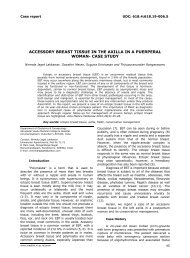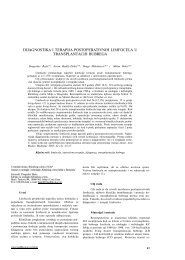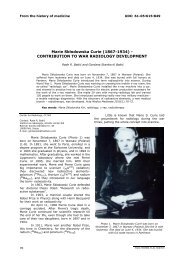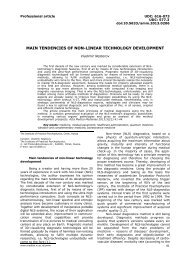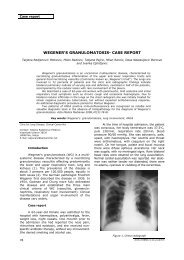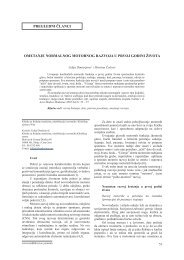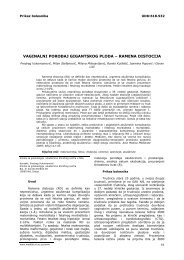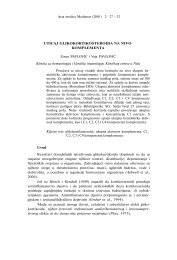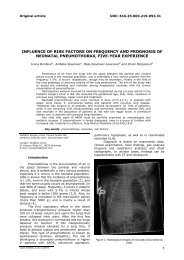plasmid profile analysis of salmonella enterica serotype enteritidis
plasmid profile analysis of salmonella enterica serotype enteritidis
plasmid profile analysis of salmonella enterica serotype enteritidis
Create successful ePaper yourself
Turn your PDF publications into a flip-book with our unique Google optimized e-Paper software.
Review article<br />
PLASMID PROFILE ANALYSIS OF SALMONELLA ENTERICA SEROTYPE<br />
ENTERITIDIS<br />
54<br />
Biljana Miljkovic-Selimovic, Tatjana Babic, Branislava Kocic, Predrag Stojanovic, Ljiljana Ristic and<br />
Marina Dinic<br />
Plasmid <strong>pr<strong>of</strong>ile</strong> <strong>analysis</strong> (PP) is a method <strong>of</strong> determining a number and size <strong>of</strong><br />
<strong>plasmid</strong>s in bacterial isolates. When using <strong>plasmid</strong> <strong>pr<strong>of</strong>ile</strong> <strong>analysis</strong> in determining<br />
epidemiological strain for evaluation <strong>of</strong> this method, it is necessary to compare<br />
epidemiological strains with non-epidemiological ones isolated in the same period <strong>of</strong><br />
time. Plasmid <strong>pr<strong>of</strong>ile</strong> determination is performed by lysis <strong>of</strong> bacterial cell,<br />
chromosomal denaturation, sedimentation <strong>of</strong> cell fragments by centrifugation, and<br />
precipitation <strong>of</strong> DNA with ethanol. DNA is separated by gel electrophoresis based on its<br />
molecule mass. Plasmids could be also analyzed by restriction enzymes, as well as by<br />
direct techniques, such as hybridization and electronomicroscopically. Using <strong>of</strong> <strong>plasmid</strong><br />
<strong>pr<strong>of</strong>ile</strong> <strong>analysis</strong> enables resolving numerous outbreaks caused by Enterobacteriaceae,<br />
especially Salmonella. This method could be performed alone for Salmonella <strong>enterica</strong><br />
<strong>serotype</strong> Enteritidis, but also as a complementary method to phage typing<br />
(phagotypization), and other molecular genetic based techniques. Acta Medica<br />
Medianae 2008;47(2):54-57.<br />
Key words: <strong>plasmid</strong> <strong>pr<strong>of</strong>ile</strong>, Salmonella <strong>enterica</strong> <strong>serotype</strong> Enteritidis<br />
Public Health Institute Clinical Center in Nis<br />
Contact: Biljana Miljkovic-Selimovic<br />
Public Health Institute Clinical Center<br />
50 Dr Zoran Djindjic Blvd.<br />
18000 Nis, Serbia<br />
Phone:+381 18 226448; 0644332238<br />
E-mail: biljams@eunet.yu<br />
Introduction<br />
Since ‘70s <strong>of</strong> the past century, along with<br />
improving methods <strong>of</strong> <strong>plasmid</strong>s isolation, the<br />
importance <strong>of</strong> researching techniques <strong>of</strong> total<br />
bacterial <strong>plasmid</strong>s contents as a mean <strong>of</strong> determining<br />
clone concept rose up. Determination <strong>of</strong> a<br />
number and size <strong>of</strong> <strong>plasmid</strong>s in bacterial isolates<br />
is called <strong>plasmid</strong> <strong>pr<strong>of</strong>ile</strong> <strong>analysis</strong> (PP) (1,2,3,4). It<br />
appears that epidemical strains <strong>of</strong> Enterobacteriaceae,<br />
bacteria <strong>of</strong> Pseudomonas and Vibrio<br />
strains, staphylococcus and streptococcus can be<br />
identified in this way (4,5). However, isolates<br />
which are not connected with the outbreak may<br />
manifest epidemical <strong>pr<strong>of</strong>ile</strong>. Thus, when using<br />
<strong>plasmid</strong> <strong>pr<strong>of</strong>ile</strong> <strong>analysis</strong> in determining epidemical<br />
strain for evaluation <strong>of</strong> this method, it is<br />
necessary to compare epidemiological strains<br />
with non-epidemiological ones isolated in the<br />
same period <strong>of</strong> time (4).<br />
Namely, determination <strong>of</strong> <strong>plasmid</strong>s <strong>pr<strong>of</strong>ile</strong><br />
is performed after the growth <strong>of</strong> culture in a<br />
liquid or on a solid medium, by breaking <strong>of</strong>f outer<br />
membrane <strong>of</strong> bacterial cell with lysosomes, inner<br />
membrane by detergent lysis, and chromosomes<br />
denaturation in alkali pH. Cell debris is sedimented<br />
by centrifugation in a microcentrifuge for a<br />
several minutes, after which DNA precipitation<br />
with ethanol follows. This method, modified to<br />
some degree, can be used for isolation <strong>of</strong> <strong>plasmid</strong><br />
DNA from majority <strong>of</strong> genera and strains related<br />
to family <strong>of</strong> Enterobacteriaceae (4). Plasmid DNA<br />
is exposed to horizontal or vertical gel electrophoresis,<br />
while process <strong>of</strong> separation, based on<br />
molecule mass, occurs during migration toward<br />
anode. Additionally, gel is painted with ethidium<br />
bromide which binds to DNA and shows the<br />
fluorescent color when exposed to UV light.<br />
Plasmid DNA with known molecule mass is<br />
recognized as a standard for every gel and its<br />
relative mobility is used in calculation <strong>of</strong> mass <strong>of</strong><br />
unknown <strong>plasmid</strong>s (4). As the length <strong>of</strong> migration<br />
relies on shape and dimension <strong>of</strong> <strong>plasmid</strong>s, we<br />
can find more strips <strong>of</strong> <strong>plasmid</strong>s on gel. Coiled<br />
molecules with covalent connections, which<br />
migrate at the highest speed, during extraction<br />
could be changed to open ring-shaped (circular)<br />
or linear forms. Since the coiled forms migrate<br />
faster than relaxed, their mutual relation and<br />
position in electrophoresis field are influenced by<br />
electric power, puffer system, the sizes <strong>of</strong> gel<br />
pores and DNA molecules. Therefore, appearing<br />
<strong>of</strong> several stripes could be interpreted in wrong<br />
manner as the existence <strong>of</strong> large number <strong>of</strong><br />
www.medfak.ni.ac.yu/amm
Acta Medica Medianae 2008,Vol.47 Plasmid <strong>pr<strong>of</strong>ile</strong> <strong>analysis</strong> <strong>of</strong> <strong>salmonella</strong> <strong>enterica</strong> <strong>serotype</strong> <strong>enteritidis</strong><br />
<strong>plasmid</strong>s, instead <strong>of</strong> multiple forms <strong>of</strong> one single<br />
<strong>plasmid</strong>. On the other hand, as the electrophoresis<br />
mobility <strong>of</strong> two different <strong>plasmid</strong>s could be<br />
the same, it is necessary to determine whether,<br />
based on examination <strong>of</strong> sequences <strong>of</strong> nucleotide<br />
bases, these <strong>plasmid</strong>s have the same molecule<br />
masses and are genetically identical.<br />
This <strong>analysis</strong> is performed by digestion <strong>of</strong><br />
<strong>plasmid</strong> with restrictive endonucleases. Techniques<br />
used in <strong>plasmid</strong> <strong>analysis</strong> could be direct or<br />
indirect. The direct techniques include (i) DNA<br />
chains hybridization with calculation <strong>of</strong> homology<br />
degree (ii) direct electronomicroscopic heteroduplex<br />
<strong>analysis</strong> <strong>of</strong> small <strong>plasmid</strong>s (nonhomological<br />
DNA would appear to be a simple loop), (iii)<br />
discovering <strong>of</strong> DNA sequences by Southern-blot<br />
hybridization with radioactive DNA probes. The<br />
indirect techniques are (i) agarose gel electrophoresis<br />
and (i) restriction endonuclease <strong>analysis</strong> (3).<br />
Comparison <strong>of</strong> strains, based on their<br />
contents <strong>of</strong> <strong>plasmid</strong>s or on restrictive <strong>pr<strong>of</strong>ile</strong>s <strong>of</strong><br />
<strong>plasmid</strong> DNA, is very useful in the case that a<br />
bacterium contains <strong>plasmid</strong>s. However, when a<br />
bacterium does not contain <strong>plasmid</strong>s, this<br />
method gives us very little benefit.<br />
Plasmid <strong>pr<strong>of</strong>ile</strong> <strong>analysis</strong> is useful in determining<br />
the epidemical strain in outbreaks caused<br />
by multiple species: Escherichia, Klebsiella, Pseudomonas,<br />
Serratia, Staphylococcus and so on<br />
(4). This method allowed successful identification<br />
<strong>of</strong> an epidemical strain P.aeruginosa isolated<br />
from patient on hemodialysis. Actually, the same<br />
strain was isolated both from patient flora and<br />
from iod<strong>of</strong>orm solution which was associated with<br />
infection spread and removed from market<br />
afterwards (6).<br />
Applying <strong>of</strong> <strong>plasmid</strong> <strong>pr<strong>of</strong>ile</strong> <strong>analysis</strong> did<br />
confirm that usual humane infection was<br />
provoked by consumption <strong>of</strong> animal originated<br />
food. Identical resistance <strong>plasmid</strong>s from Salmonella<br />
serovars isolated from humans and animals,<br />
in the case <strong>of</strong> Salmonella <strong>enterica</strong> serovar<br />
Typhimurium (S.Typhimurium) var Copenhagen,<br />
S. Newport, and S. Dublin have been obtained<br />
from different geographic areas in the US.<br />
Thanks to the <strong>plasmid</strong> <strong>pr<strong>of</strong>ile</strong> <strong>analysis</strong> <strong>of</strong> these<br />
strains, it has been confirmed that they spread<br />
out by means <strong>of</strong> using animal-originated food.<br />
The method <strong>of</strong> restriction endonuclease <strong>analysis</strong><br />
has shown that <strong>plasmid</strong>s from animal and human<br />
isolates were quite <strong>of</strong>ten identical or almost<br />
identical (7).<br />
In examination <strong>of</strong> epidemical strains<br />
S.Typhimurium there is a common opinion that<br />
method <strong>of</strong> <strong>plasmid</strong> <strong>pr<strong>of</strong>ile</strong> <strong>analysis</strong> is easy to use,<br />
equally specific as phagotypization, and superior<br />
against biotypization and resistotypization (8).<br />
Plasmid <strong>pr<strong>of</strong>ile</strong> <strong>analysis</strong> has enabled discovering<br />
<strong>of</strong> infection source associated with multiresistant<br />
(MR) strains <strong>of</strong> S.Typhimurim in Sao Paolo<br />
(Brazil). It is established that infections associated<br />
with strains with the same <strong>plasmid</strong> <strong>pr<strong>of</strong>ile</strong><br />
occurred among children hospitalized in the same<br />
hospital, thus endemic process consisted <strong>of</strong><br />
series <strong>of</strong> small outbreaks raised by infection<br />
among children in some hospitals.<br />
Plasmid <strong>pr<strong>of</strong>ile</strong> <strong>analysis</strong> has proved as<br />
successful method in solving <strong>of</strong> outbreaks caused<br />
by S.Typhimurium in our laboratories, too. In an<br />
outbreak associated with this serovar occurred in<br />
a military base, Cobeljic et al. have detected<br />
epidemic strain in <strong>plasmid</strong>s <strong>of</strong> 30 MDa and 60<br />
MDa. The strain was isolated from the patient’s<br />
stool, from the cook as a carrier <strong>of</strong> infection and<br />
from food. At the same time, analyzing the other<br />
outbreak in the base, the same authors pointed<br />
out that strains <strong>of</strong> the same serovar could be<br />
isolated from the outbreak, which were not<br />
associated with it (10).<br />
Plasmid <strong>pr<strong>of</strong>ile</strong> <strong>analysis</strong> enables solving<br />
outbreaks caused by other <strong>salmonella</strong>s. In an<br />
outbreak associated with S.Newport, in the US, it<br />
was established that a beef from the farm was<br />
the origin <strong>of</strong> epidemic since each strain, isolated<br />
from patients had R <strong>plasmid</strong> which conditioned<br />
resistance to ampicillin, carbencillin, and tetracycline.<br />
Though many people were infected, only<br />
those, who did allow selective advantage and<br />
growth by antibiotics, became ill (11).<br />
In several US states, <strong>plasmid</strong> <strong>pr<strong>of</strong>ile</strong> in<br />
strains isolated from patient’s stools with<br />
enterocolitis caused by S. Muenchen, and from<br />
marihuana, allowed identification <strong>of</strong> an epidemic<br />
strain with unusual way <strong>of</strong> spreading (12). At the<br />
Health Care Institute in Novi Sad, there were<br />
isolates <strong>of</strong> S. Hadar, associated with an outbreak<br />
and obtained from patient’s and the restaurant<br />
employees stools, and from food, resistant to<br />
ampicillin and streptomycin. Plasmid <strong>pr<strong>of</strong>ile</strong><br />
<strong>analysis</strong> revealed presence <strong>of</strong> five <strong>plasmid</strong> stripes<br />
with molecule masse <strong>of</strong> 13, 5.4, 4.2, 2.0, and 1.7<br />
MDa (13).<br />
By <strong>plasmid</strong> <strong>pr<strong>of</strong>ile</strong> <strong>analysis</strong>, we can<br />
determine a different number <strong>of</strong> <strong>pr<strong>of</strong>ile</strong>s, which<br />
depends on geographic location <strong>of</strong> isolates, time<br />
<strong>of</strong> researching, as well as the origin <strong>of</strong> strains,<br />
that is, whether they are isolated from human,<br />
animal or from food. In 2005, in Scotland, in 523<br />
<strong>of</strong> 543 isolates (96.3%) <strong>of</strong> S. Enteritidis, which is<br />
one <strong>of</strong> the most common serovar, there was<br />
found one <strong>plasmid</strong> at least. In 269 <strong>of</strong> these<br />
isolates (49.5%), there was only virulence<br />
<strong>plasmid</strong> <strong>of</strong> 57 kb, and twenty isolates did not<br />
contain any <strong>plasmid</strong>. At 134 PT1 isolates there<br />
were described 16 different <strong>plasmid</strong> <strong>pr<strong>of</strong>ile</strong>s, and<br />
11 <strong>pr<strong>of</strong>ile</strong>s were found in 117 PT4 isolates. In the<br />
rest <strong>of</strong> 292 isolates <strong>of</strong> S. Enteritidis, there were<br />
found 74 different <strong>plasmid</strong> <strong>pr<strong>of</strong>ile</strong>s (14).<br />
Investigating strains <strong>of</strong> S. Enteritidis<br />
isolated from people and different animals, there<br />
were identified sixteen different <strong>plasmid</strong> <strong>pr<strong>of</strong>ile</strong>s<br />
which were used to make a difference between<br />
strains especially among most common<br />
phagotypes (PT 8 and PT 13a) (15). In the study<br />
carried out on 318 strains <strong>of</strong> S. Enteritidis<br />
isolated from poultry and its environment in<br />
Canada, there were evidenced 12 phagotypes.<br />
However, among these strains it was possible to<br />
determine fifteen different <strong>plasmid</strong> <strong>pr<strong>of</strong>ile</strong>s (16).<br />
Investigating <strong>plasmid</strong> <strong>pr<strong>of</strong>ile</strong> <strong>of</strong> S.<br />
Enteritidis isolated from poultry during 1989 –<br />
‘90 in Canada, the authors have proved twelve<br />
<strong>plasmid</strong> <strong>pr<strong>of</strong>ile</strong>s against just four phagotypes<br />
55
Plasmid <strong>pr<strong>of</strong>ile</strong> <strong>analysis</strong> <strong>of</strong> <strong>salmonella</strong> <strong>enterica</strong> <strong>serotype</strong> <strong>enteritidis</strong> Biljana Miljković-Selimović et al.<br />
(17). Investigating 105 strains <strong>of</strong> S.Enteritidis<br />
(72 <strong>of</strong> them had human origin and 33 non-<br />
human origin) isolated in the period from 1975 to<br />
1995, seven different <strong>plasmid</strong> <strong>pr<strong>of</strong>ile</strong>s were<br />
proved, while 96% isolates had have <strong>plasmid</strong> <strong>of</strong><br />
around 36 MDa (18). Investigating 64 isolates <strong>of</strong><br />
S.Enteritidis from laboratory collection <strong>of</strong> Enterobacteriaceae<br />
at the University <strong>of</strong> Medical Science<br />
in Ankara, 88% <strong>of</strong> examined isolates had from 1<br />
up to 4 <strong>plasmid</strong>s which sizes varied from 2.5 to<br />
100 kbp. Plasmid <strong>of</strong> 57 kbp was the most common<br />
and it was proved in 69% <strong>of</strong> isolates as a single one<br />
or along with the other <strong>plasmid</strong>s (19).<br />
Plasmid <strong>pr<strong>of</strong>ile</strong> is determined for 276<br />
strains <strong>of</strong> S.Enteritidis isolated at the Public<br />
Health Institute in Nis. From 94 isolates there<br />
were investigated 28 epidemic and 182 non-<br />
epidemic strains. Plasmid <strong>pr<strong>of</strong>ile</strong> <strong>analysis</strong> <strong>of</strong><br />
epidemic and non-epidemic strains showed up to<br />
12 <strong>plasmid</strong> <strong>pr<strong>of</strong>ile</strong>s. Among the two most<br />
common <strong>plasmid</strong> <strong>pr<strong>of</strong>ile</strong>: PP 38 MDa and PP 38<br />
2MDa, <strong>plasmid</strong> <strong>pr<strong>of</strong>ile</strong>s with <strong>plasmid</strong> sizes <strong>of</strong> 4.0,<br />
3.4, 2.7, and 1.5 MDa were determined too, as<br />
well as PP with large <strong>plasmid</strong>s <strong>of</strong> 34 and 27Mda,<br />
though scattered (20).<br />
Plasmid <strong>pr<strong>of</strong>ile</strong> <strong>analysis</strong> was successfully<br />
applied to resolving outbreaks associated with<br />
S.Enteritidis. Researching the outbreak <strong>of</strong><br />
enterocolitis at restaurant chain in Meriland,<br />
<strong>plasmid</strong> <strong>pr<strong>of</strong>ile</strong> (55, 3.5, and 2.5 kb) was<br />
determined in isolates <strong>of</strong> S.Enteritidis isolated<br />
from every patient. The probability that this<br />
<strong>plasmid</strong> <strong>pr<strong>of</strong>ile</strong> was randomly associated to the<br />
outbreak was less than 0.05 (21). By researching<br />
<strong>of</strong> an outbreak at the University <strong>of</strong> Medical<br />
Science in Ankara, it was determined that<br />
outbreak strains carried the same <strong>plasmid</strong><br />
<strong>pr<strong>of</strong>ile</strong>: three <strong>plasmid</strong>s with size <strong>of</strong> 57, 40, and<br />
3.0 kbp (19). An outbreak caused by S.Enteritidis<br />
phagotype 13 (S. Enteritidis PT13) occurred in<br />
Czech Republic. The strain belonged to rare<br />
phagotype and was susceptible to ampicillin. Both<br />
pre-epidemic and post-epidemic isolated strains<br />
were inspected by method <strong>of</strong> <strong>plasmid</strong> <strong>pr<strong>of</strong>ile</strong><br />
<strong>analysis</strong>. It was determined that ampicillin<br />
resistance was associated with <strong>plasmid</strong> <strong>of</strong> 200<br />
kb, which was evidenced at S. Enteritidis (20).<br />
1. Orskov F, Orskov I. Summary <strong>of</strong> a workshop on the<br />
clone concept in the epidemiology, taxonomy, and<br />
evolution <strong>of</strong> the Enterobacteriaceae and other<br />
bacteria. J Infect Dis 1983;148:346-57.<br />
2. Riley LW, DiFerdinando GT Jr, DeMelfi TM, Cohen<br />
ML. Evaluation <strong>of</strong> isolated cases <strong>of</strong> salmonellosis by<br />
<strong>plasmid</strong> <strong>pr<strong>of</strong>ile</strong> <strong>analysis</strong>: introduction and<br />
transmission <strong>of</strong> a bacterial clone by precooked roast<br />
beef. J Infect Dis 1983;148:12-7.<br />
3. Farrar WE Jr. Molecular <strong>analysis</strong> <strong>of</strong> <strong>plasmid</strong>s in<br />
epidemiologic investigation. J Infect Dis 1983; 148:1-6.<br />
4. Wachsmuth K. Molecular epidemiology <strong>of</strong> bacterial<br />
infections: examples <strong>of</strong> methodology and <strong>of</strong> investigations<br />
<strong>of</strong> outbreaks. Rev Infect Dis 1986;8:682-92.<br />
5. Tompkins L. DNA methods in clinical microbiology.<br />
In: Lenette EH, Manual <strong>of</strong> clinical microbiology (4th<br />
edition), Washington D.C.: American Society for<br />
Microbiology;1985. p1023-28.<br />
56<br />
References<br />
Regarding PT 8 strains <strong>of</strong> S.Enteritidis, it is<br />
considered that spreading <strong>of</strong> this dominating<br />
clone with evidenced PP 38MDa mostly, did<br />
decrease discrimination ability <strong>of</strong> both typization<br />
systems. By investigation <strong>of</strong> 203 sporadic and<br />
epidemic isolates <strong>of</strong> S.Enteritidis isolated in<br />
Meriland between 1985 and 1990, ten <strong>plasmid</strong><br />
<strong>pr<strong>of</strong>ile</strong>s were identified. The most dominating<br />
<strong>pr<strong>of</strong>ile</strong> was PP 55kba (38MDa); it was 86% <strong>of</strong><br />
total <strong>plasmid</strong> <strong>pr<strong>of</strong>ile</strong>s from isolates <strong>of</strong> this<br />
phagotype isolated from 1988 - ’89 (23).<br />
In another investigation, <strong>plasmid</strong> <strong>pr<strong>of</strong>ile</strong><br />
<strong>analysis</strong> was superior in comparison to phagotypization<br />
<strong>of</strong> PT 8 strains because it was possible to<br />
describe six different <strong>plasmid</strong> <strong>pr<strong>of</strong>ile</strong>s versus<br />
single one phagotype. On the other hand, three<br />
strains without <strong>plasmid</strong> <strong>of</strong> 55 kba (38 MDa) could<br />
be differentiated by applying two additional<br />
phages (24). These results point out that, in<br />
some cases, determination <strong>of</strong> <strong>plasmid</strong> <strong>pr<strong>of</strong>ile</strong> and<br />
phagotypization could be complementary methods.<br />
By some other authors, determination <strong>of</strong><br />
<strong>plasmid</strong> <strong>pr<strong>of</strong>ile</strong> is an addition to phagotypization.<br />
Investigation <strong>of</strong> 27 phagotype representatives <strong>of</strong><br />
S.Enteritidis revealed that only eleven <strong>plasmid</strong><br />
<strong>pr<strong>of</strong>ile</strong>s could be identified. Two <strong>pr<strong>of</strong>ile</strong>s were<br />
proved in fifteen PT4 and 8 strains, which are two<br />
most common phagotypes in Great Britain. The<br />
<strong>plasmid</strong> <strong>pr<strong>of</strong>ile</strong> variations useful for epidemiologic<br />
researches were found in thirteen phagotypes (25).<br />
S.Enteritidis PT 4 had nine different <strong>plasmid</strong> <strong>pr<strong>of</strong>ile</strong>s<br />
(26,26). Thus <strong>plasmid</strong> <strong>pr<strong>of</strong>ile</strong> <strong>analysis</strong> could be<br />
accepted as effective addition to phagotypization by<br />
opinion <strong>of</strong> mentioned authors. It also considered<br />
that <strong>plasmid</strong> <strong>pr<strong>of</strong>ile</strong> <strong>analysis</strong> is very useful for<br />
differentiation between PT 4 strains (27).<br />
Through another studies, the researches<br />
pointed out instability <strong>of</strong> S. Enteritidis’ <strong>plasmid</strong>s<br />
in isolates <strong>of</strong> different origin. Investigating a<br />
nosocomial outbreak associated with S. Enteritidis<br />
in US, partial differences between <strong>plasmid</strong><br />
<strong>pr<strong>of</strong>ile</strong>s among strains isolated from patients<br />
were determined (54 kb the first ones, 54, and<br />
8.4 kb the second ones, and 54 and > 100 kb the<br />
third ones), food (54 kb) and chicken’s ovary<br />
(54), while strain associated with fresh eggs did<br />
not contain any <strong>plasmid</strong>s (28).<br />
6. Parrot PL, Terry PM, Whitworth EH, Frawley LW,<br />
Cable RS, Wachsmuth IK, et al. Pseudomonas<br />
aeruginosa peritonitis associated with contaminated<br />
poloxameriodine solutions. Lancet 1982; ii: 683-5.<br />
7. O'Brien TF, Hopkins JD, Gilleece ES, Medeiros AA,<br />
Kent RL, Blackburn BO. et al. Molecular epidemiology<br />
<strong>of</strong> a antibiotic resistance in <strong>salmonella</strong> from<br />
animals and human beings in the United States. N<br />
Engl J Med. 1982;307:1-6.<br />
8. Threlfall EJ, Rowe B, Ferguson JL, Ward LR.<br />
Characterization <strong>of</strong> <strong>plasmid</strong>s conferring resistance to<br />
gentamicin and apramycin in strains <strong>of</strong> Salmonella<br />
typhimurium phage type 204c isolated in Britain. J<br />
Hyg Camb, 1986;97:419-26.<br />
9. Riley LW, Ceballos BS, Trabulsi LR, Fernandes de<br />
Toledo MR, Blake PA. The significance <strong>of</strong> hospitals<br />
as reservoirs for endemic multiresistant Salmonela
Acta Medica Medianae 2008,Vol.47 Plasmid <strong>pr<strong>of</strong>ile</strong> <strong>analysis</strong> <strong>of</strong> <strong>salmonella</strong> <strong>enterica</strong> <strong>serotype</strong> <strong>enteritidis</strong><br />
typhimurium causing infection in urban Brazilian<br />
children. J Infect Dis 1984;150:236-41.<br />
10. Cobeljić M, Stojiljkovic I, Salaj-Šmic E, Drndarevic<br />
D, Stojadinovic N, Paunovic, i sar. Primena analize<br />
plazmidskog pr<strong>of</strong>ila u ispitivanju epidemija alimentarnih<br />
toksiinfekcija. Vojnosanit Pregl 1986; 5:335-9<br />
11. Holmberg SD, Osterholm MT. Senger KA. Drug<br />
resistant <strong>salmonella</strong> from animals fed antimicrobials.<br />
N Engl J Med 1984;311:6l7-22.<br />
12. Taylor DN, Wachsmuth KI, Shangkuan Y, Schmidt<br />
EV, Barrett TJ, Schrader IS, et al. Salmonellosis<br />
associated with marijuana. A multistate outbreak<br />
traced by <strong>plasmid</strong> fingerprinting. N Engl J Med<br />
1982;306:1249-53.<br />
13. Jelasic Z, Kulauzov M, Kozoderovic G. Analysis <strong>of</strong><br />
the <strong>plasmid</strong> <strong>pr<strong>of</strong>ile</strong> <strong>of</strong> various Salmonella <strong>serotype</strong>s.<br />
Med Pregl 2000;53(11-12):564-7.<br />
14. Health protection Scotland.The Scottish Salmonella<br />
Reference Laboratory. Gastrointestinal & Zoonoses.<br />
Weekly Report Articles 02 May. Available from:<br />
URL:2007http://www.hps.scot.nhs.uk/giz/wrdetail.a<br />
spx?id=34171&wrtype=9#<br />
15. Wachsmuth IK, Kiehlbauch JA, Bopp CA, Cameron<br />
DN, Strockbine NA, Wells JG, et al. The use <strong>of</strong><br />
<strong>plasmid</strong> <strong>pr<strong>of</strong>ile</strong>s and nucleic acid probes in<br />
epidemiologic investigations <strong>of</strong> foodborne, diarrheal<br />
diseases. Int J Food Microbiol 1991;12:77-89.<br />
16. Poppe C, Demczuk W, McFadden K, Johnson RP.<br />
Virulence <strong>of</strong> Salmonella <strong>enteritidis</strong> phagetypes 4, B<br />
and 13 and other Salmonella spp. for day-old chiks,<br />
heans and mice. Can J Vet Res 1993;57:281-7.<br />
17. Dorn CR, Silapanuntakul R, Angrick EJ, Shipman LD.<br />
Plasmid <strong>analysis</strong> and epidemiology <strong>of</strong> Salmonella<br />
<strong>enteritidis</strong> infection in three commercial layer flocks.<br />
Avian Dis 1992;36: 844-51.<br />
18. Fernandes SA, Ghilardi AC, Tavechio AT, Machado AM,<br />
Pignatari AC. Phenotypic and molecular characterization<br />
<strong>of</strong> Salmonella Enteritidis strains isolated in São<br />
Paulo, Brazil. Rev Inst Med Trop Sao Paulo.<br />
2003;2:59-63.<br />
19. Tekeli A, Erdem B, Sahin F, Koyuncu E, Karasartova D,<br />
Bayramova M. Plasmid <strong>pr<strong>of</strong>ile</strong>s and randomly amplified<br />
polymorphic DNA <strong>analysis</strong> <strong>of</strong> Salmonella <strong>enterica</strong><br />
<strong>serotype</strong> Enteritidis strains from outbreaks and<br />
sporadic cases in Turkey. New Microbiol 2006;<br />
29(4):251-60.<br />
20. Miljkovic-Selimovic B. Karakteristike plazmidskih<br />
pr<strong>of</strong>ila Salmonellae <strong>enteritidis</strong>. Medicinski fakultet:<br />
Univerzitet u Nisu; 1997.<br />
21. Lin F-YC, Morris, GJ Jr, Trump D, Tilghman D, Wood<br />
PK, Jackman N, Israel E, Libonati PJ. Investigation<br />
<strong>of</strong> an outbreak <strong>of</strong> Salmonella <strong>enteritidis</strong> gastroenteritis<br />
associated with consumption <strong>of</strong> eggs in a<br />
restaurant chain in Maryland. Am J Epidemiol<br />
1988;128:839-44.<br />
22. Hradecka H, Kolackova I, Karpiskova R, Rychlik I.<br />
An outbreak <strong>of</strong> human salmonellosis caused by<br />
ampicillin-resistant Salmonella <strong>enterica</strong> serovar<br />
Enteritidis PT13 in the Czech Republic. Epidemiol<br />
Infect 2006;134(4):737-40.<br />
23. Morris JG Jr, Dwyer DM, Hoge CW, Stubbs AD,<br />
Tilghman D, Groves C, et al. Changing clonal<br />
patterns <strong>of</strong> Salmonella <strong>enteritidis</strong> in Maryland:<br />
evaluation <strong>of</strong> strains isolated between 1985 and<br />
1990. J Clin Microbiol 1992;30:1301-3.<br />
24. Stubbs AD, Hickman-Brenner FW, Cameron DN,<br />
Farmer JJIII. Differentiation <strong>of</strong> Salmonella <strong>enteritidis</strong><br />
phage type 8 strains: evaluation <strong>of</strong> three additional<br />
phage typing systems, <strong>plasmid</strong> <strong>pr<strong>of</strong>ile</strong>s, antibiotic<br />
susceptibility patterns, and biotyping. J Clin<br />
Microbiol 1994;32:199-201.<br />
25. Miljkovic-Selimovic B, Babib T, Kocic B, Stojanovic<br />
P, Ristic Lj, Dinic M. Bakterijski plazmidi. Acta<br />
Medica Medianae 2007;46(4):61-5.<br />
26. Threlfall EJ, Rowe B, Ward LR. Subdivision <strong>of</strong><br />
Salmonella <strong>enteritidis</strong> phage types by <strong>plasmid</strong><br />
<strong>pr<strong>of</strong>ile</strong> typing. Epidemiol Infect 1989;102:459-65.<br />
27. Powell NG, Therefall EJ, Chart H, Rowe B.<br />
Subdivision <strong>of</strong> Salmonella <strong>enteritidis</strong>, PT 4 by<br />
pulsed-field gel electropgoresis: potential for<br />
epidemiological surveillance. FEMS Microbiol Lett<br />
1994;119:193-8.<br />
28. Erdem B, Threlfall EJ, Sch<strong>of</strong>ield SL, Ward LR, Rowe<br />
B. Plasmid <strong>pr<strong>of</strong>ile</strong> typing provides a method for the<br />
differentiation <strong>of</strong> strains <strong>of</strong> Salmonella <strong>enteritidis</strong><br />
phage type 4 isolated in Turkey. Lett Appl Microbiol<br />
1994;19:265-7.<br />
29. Telzak EE, Budnick LD, Greenberg MS, Blum S,<br />
Shayegani M, Benson CE, et al. A nosocomial<br />
outbreak <strong>of</strong> Salmonella <strong>enteritidis</strong> infection due to<br />
the consumption <strong>of</strong> raw eggs. N Engl J Med,<br />
1990;6:394-7.<br />
ANALIZA PLAZMIDSKOG PROFILA SALMONELLAE ENTERICA SEROTIP<br />
ENTERITIDIS<br />
Biljana Miljković-Selimović, Tatjana Babić, Branislava Kocić, Predrag Stojanović, Ljiljana Ristić i Marina<br />
Dinić<br />
Analiza plazmidskog pr<strong>of</strong>ila (PP) je određivanje broja i veličine plazmida u bakterijskim<br />
izolatima. Prilikom primene analize plazmidskog pr<strong>of</strong>ila u određivanju epidemijskog soja za<br />
procenu ove metode, neophodno je porediti epidemijske sojeve sa neepidemijskim<br />
sojevima izolovanih u istom vremenskom periodu. Određivanje plazmidskog pr<strong>of</strong>ila vrši se<br />
lizom bakterijske ćelije, denaturacijom hromozoma, taloženjem ćelijskih ostataka<br />
centrifugiranjem i precipitacijom DNK etanolom. DNK se razdvaja elektr<strong>of</strong>orezom u gelu na<br />
osnovu molekulske mase. Plazmidi mogu biti analizirani i restrikcionim enzimima, ali i<br />
direktnim tehnikama, hibridizacijom i elektronomikroskopski. Primena analize plazmidskog<br />
pr<strong>of</strong>ila je omogućila rešavanje brojnih epidemija izazvanih crevnim bakterijama, naročito<br />
salmonelama. Kada je u pitanju Salmonella <strong>enterica</strong> serotip Enterititidis, metoda se može<br />
koristiti sama, kao metoda komplementarna fagotipizaciji, ali se može dopunjavati i<br />
drugim molekularno-genetskim tehnikama. Acta Medica Medianae 2008;47(2):54-57.<br />
Ključne reči: plazmidski pr<strong>of</strong>il, Salmonella <strong>enterica</strong> serotip Enteritidis<br />
57



